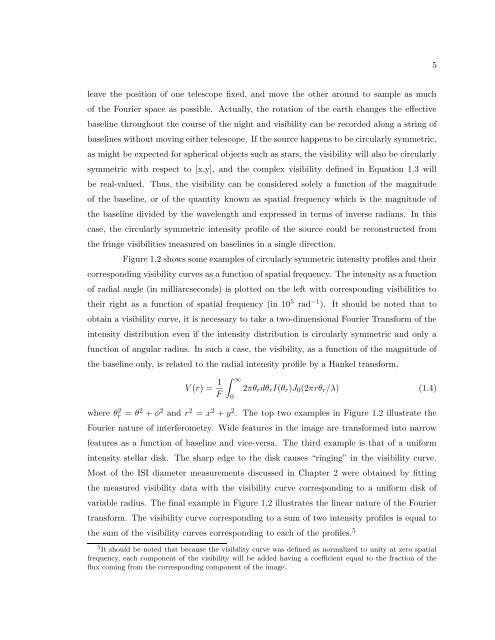The Size, Structure, and Variability of Late-Type Stars Measured ...
The Size, Structure, and Variability of Late-Type Stars Measured ...
The Size, Structure, and Variability of Late-Type Stars Measured ...
You also want an ePaper? Increase the reach of your titles
YUMPU automatically turns print PDFs into web optimized ePapers that Google loves.
5<br />
leave the position <strong>of</strong> one telescope fixed, <strong>and</strong> move the other around to sample as much<br />
<strong>of</strong> the Fourier space as possible. Actually, the rotation <strong>of</strong> the earth changes the effective<br />
baseline throughout the course <strong>of</strong> the night <strong>and</strong> visibility can be recorded along a string <strong>of</strong><br />
baselines without moving either telescope. If the source happens to be circularly symmetric,<br />
as might be expected for spherical objects such as stars, the visibility will also be circularly<br />
symmetric with respect to [x,y], <strong>and</strong> the complex visibility defined in Equation 1.3 will<br />
be real-valued. Thus, the visibility can be considered solely a function <strong>of</strong> the magnitude<br />
<strong>of</strong> the baseline, or <strong>of</strong> the quantity known as spatial frequency which is the magnitude <strong>of</strong><br />
the baseline divided by the wavelength <strong>and</strong> expressed in terms <strong>of</strong> inverse radians. In this<br />
case, the circularly symmetric intensity pr<strong>of</strong>ile <strong>of</strong> the source could be reconstructed from<br />
the fringe visibilities measured on baselines in a single direction.<br />
Figure 1.2 shows some examples <strong>of</strong> circularly symmetric intensity pr<strong>of</strong>iles <strong>and</strong> their<br />
corresponding visibility curves as a function <strong>of</strong> spatial frequency. <strong>The</strong> intensity as a function<br />
<strong>of</strong> radial angle (in milliarcseconds) is plotted on the left with corresponding visibilities to<br />
their right as a function <strong>of</strong> spatial frequency (in 10 5 rad −1 ). It should be noted that to<br />
obtain a visibility curve, it is necessary to take a two-dimensional Fourier Transform <strong>of</strong> the<br />
intensity distribution even if the intensity distribution is circularly symmetric <strong>and</strong> only a<br />
function <strong>of</strong> angular radius. In such a case, the visibility, as a function <strong>of</strong> the magnitude <strong>of</strong><br />
the baseline only, is related to the radial intensity pr<strong>of</strong>ile by a Hankel transform,<br />
V (r) = 1 F<br />
∫ ∞<br />
0<br />
2πθ r dθ r I(θ r )J 0 (2πrθ r /λ) (1.4)<br />
where θ 2 r = θ 2 + φ 2 <strong>and</strong> r 2 = x 2 + y 2 . <strong>The</strong> top two examples in Figure 1.2 illustrate the<br />
Fourier nature <strong>of</strong> interferometry. Wide features in the image are transformed into narrow<br />
features as a function <strong>of</strong> baseline <strong>and</strong> vice-versa. <strong>The</strong> third example is that <strong>of</strong> a uniform<br />
intensity stellar disk. <strong>The</strong> sharp edge to the disk causes “ringing” in the visibility curve.<br />
Most <strong>of</strong> the ISI diameter measurements discussed in Chapter 2 were obtained by fitting<br />
the measured visibility data with the visibility curve corresponding to a uniform disk <strong>of</strong><br />
variable radius. <strong>The</strong> final example in Figure 1.2 illustrates the linear nature <strong>of</strong> the Fourier<br />
transform. <strong>The</strong> visibility curve corresponding to a sum <strong>of</strong> two intensity pr<strong>of</strong>iles is equal to<br />
the sum <strong>of</strong> the visibility curves corresponding to each <strong>of</strong> the pr<strong>of</strong>iles. 5<br />
5 It should be noted that because the visibility curve was defined as normalized to unity at zero spatial<br />
frequency, each component <strong>of</strong> the visibility will be added having a coefficient equal to the fraction <strong>of</strong> the<br />
flux coming from the corresponding component <strong>of</strong> the image.













![Problem #1 [Structure Formation I: Radiation Era]](https://img.yumpu.com/37147371/1/190x245/problem-1-structure-formation-i-radiation-era.jpg?quality=85)


